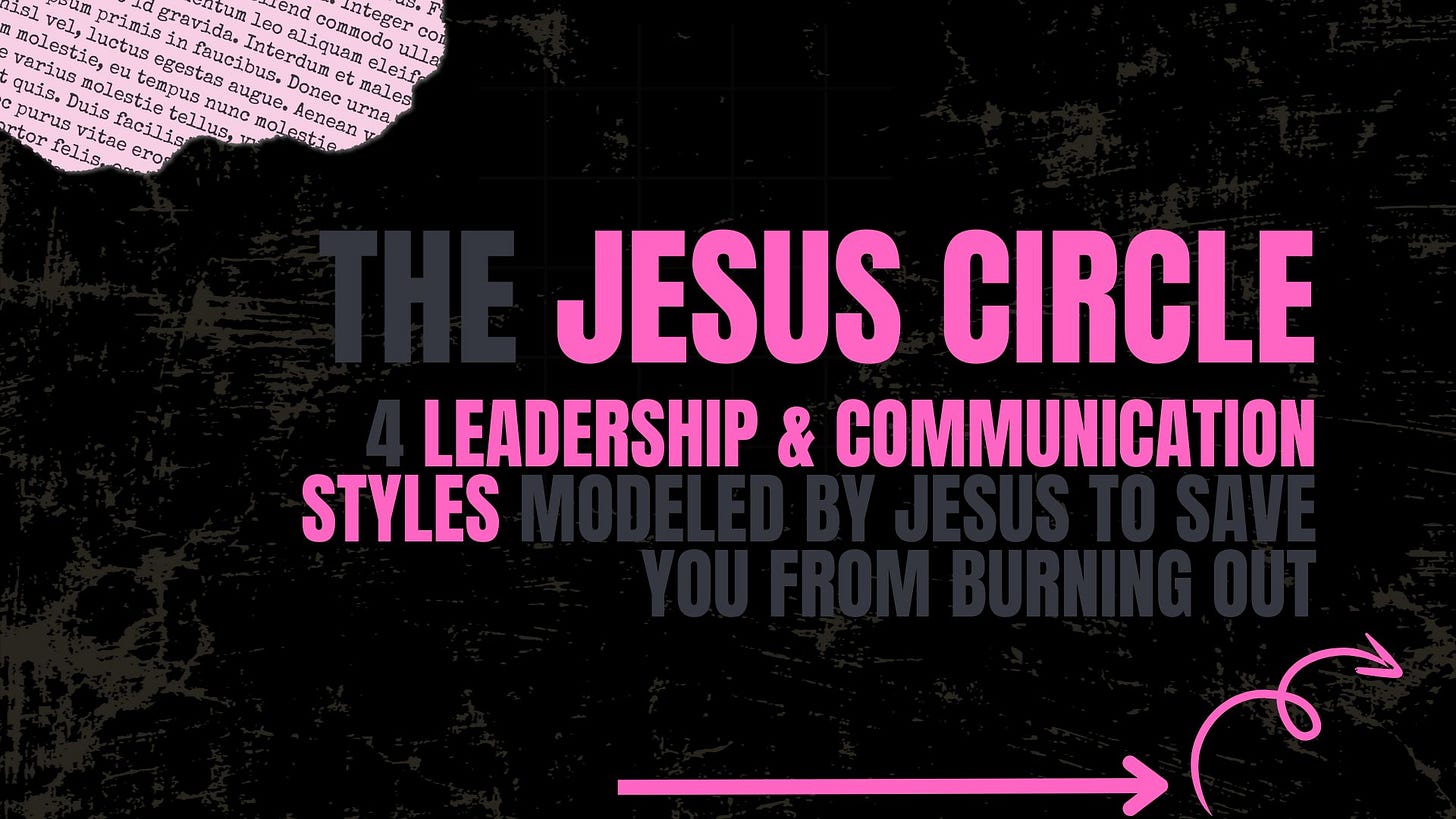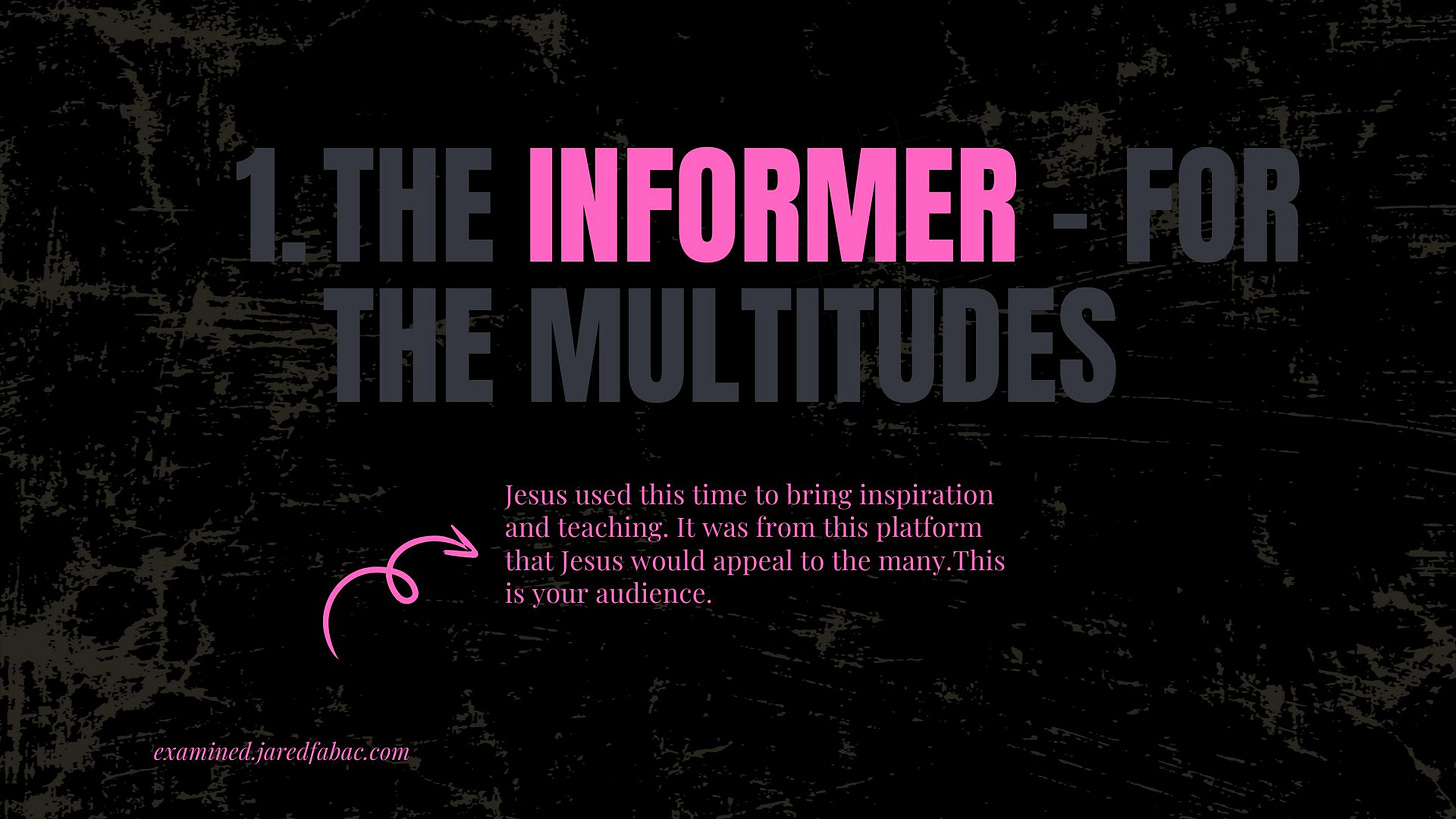The Jesus Circle - A Framework That Will Save You From Leadership Burnout
Why Managing Everyone Equally Is the Fastest Way to Exhaustion
Most leaders don’t burnout because they’re tired. Instead, it’s that they’ve tried to become all things to all people.
They show up early, stay late, answer every message, take every meeting, and try to give equal energy to every person who asks for it. The motive is pure. The impact is not.
Eventually, exhaustion sets in. Priorities fades. And the very people they were trying to develop walk away under-resourced, under-led, and confused about where they really stood.
If you’ve ever felt the weight of leading a lot of people while multiplying no one, this is probably why.
I’ve worked with a lot of different kinds of leaders, in both businesses and churches, and the pattern is always the same:
Even the best leaders break under the pressure of trying to lead everyone the same.
But here’s what we must realize…Jesus didn’t do that and neither should we.
When Equal Investment Becomes a Leadership Liability
There’s a phrase that sounds noble on the surface but dangerous in practice: “I just want to treat everyone equally.”
The problem is, not everyone has the same assignment in your life. Not everyone needs the same access. And not everyone has the same capacity.
What if honoring people equally doesn’t mean investing in them equally?
That’s the question that changed everything for me. And it’s one Jesus answered clearly in His own leadership model.
Before we break it down, let’s anchor this in Scripture.
“Jesus went up on a mountainside and called to him those he wanted, and they came to him. He appointed twelve that they might be with him and that he might send them out to preach.” - Mark 3:13-14 NIV
These two verses are more than a stepping stone in Jesus’ ministry. I see them as a masterclass in leadership clarity.
Think of all the people that Jesus led throughout his ministry.
He had the crowds. He had the seventy. But He intentionally narrowed His deepest investment to twelve. And within those twelve, there were three (Peter, James, and John) who had unique access to His most intimate moments.
He didn’t apologize for it. He didn’t explain it. He modeled it.
Jesus knew that if you want to multiply impact, you have to differentiate investment.
That’s not favoritism. That’s stewardship.
And it’s a pattern we desperately need to recover in today’s leadership culture.
The Four Circles of Intentional Leadership Investment
When you look at how Jesus distributed His time and influence, four intentional layers emerge:
1. “The 100” Circle – The Crowd
These are the people who receive your inspiration. They’re moved by your message and just excited to be close to your leadership. They attend your talks, use your service, follow your content, show up to the big events.
You’re not mentoring them. You’re casting vision, creating clarity, and helping them take their next step.
You don’t owe everyone in this group your time. You owe them direction.
Think of them as the people who need your inspiration, not your calendar.
2. “The 70” Circle – The Trained
This group goes deeper. They’re bought into the vision. They want to grow. They’ve said yes to development. This is the group that wants to be apart of carrying out the mission they were inspired by when they part of the crowd.
They don’t need personal coaching yet. They need structure. Systems. Learning environments where they can absorb what you know and put it into practice.
This is where you build programs, lead workshops, and offer access without overcommitting your capacity.
The seventy are where momentum becomes movement—but not unless you steward it wisely.
3. “The 12” Circle – The Coached
This circle is your core team. These are the people you meet with consistently. You know their stories. You see their blind spots. You help them problem-solve and grow as people, not just producers.
Jesus ate with these men. Walked with them. Laughed and wept with them. He didn’t just teach them—He transformed them through proximity.
You can’t coach 50 people. But you can pour into a dozen with intentionality.
4. “The 3” Circle – The Mentored
Peter, James, and John. They were with Him on the mountain. In the garden. At the center of both His glory and His grief.
This final circle is where legacy lives.
You’re not just coaching them. You’re preparing them to carry your influence further than you ever could alone.
You share strategy. You process failure. You build trust. And you invite them into rooms where decisions are made.
Not everyone can handle this level of access. But when you find the right people, it changes everything.
Why This Framework Protects You From Burnout
When leaders ignore these layers, they end up doing one of two things:
They give too much to people who were never supposed to have it.
They underinvest in the ones who could’ve multiplied it.
Neither leads to multiplication.
Jesus didn’t spend twelve hours explaining parables to the crowd. He taught, then moved. But with the twelve? He clarified. And with the three? He confided.
Mark 3:14 says He “appointed twelve that they might be with him.”
That line matters. Notice the subtle detail.
Jesus didn’t change his life so he could make himself available the 12, he appointed the 12 so they could be positioned to be present where he needed to be.
Leadership isn’t scalable when proximity isn’t intentional. It’s also not scalable when a leader takes himself out of his priorities to make proximity more convenient.
This framework gives you permission to say no to who’s not ready and focus deeply on the few who are.
How to Protect the Right Circles at the Right Time
Once you start defining your 100, 70, 12, and 3, the next challenge is sticking to it. The temptation will always be to blur the lines. To give coaching-level access to someone who belongs in the training circle. To let guilt or charisma pull you into overcommitment.
But if Jesus didn’t give equal access to everyone, you shouldn’t feel bad for doing the same.
Your responsibility is to steward access through clarity, not emotion.
Here’s how to protect your energy and multiply your leadership impact inside each layer:
The 100 Circle: Cast Vision With Inspiration
This group is often the loudest. They come with enthusiasm, passion, sometimes even high expectations. But they’re not your assignment for deep development.
Protect your energy here by:
Creating systems for communication
Automating processes where available
Informing, teaching, and inspiring in large group settings without offering coaching
You don’t owe everyone a time investment but you do owe them direction. Set clear boundaries with grace, and offer them the tools they need to grow at scale.
The 70 Circle: Deliver Structure Without Becoming the Structure
This is the group that’s hungry and committed. They’re ready to be developed. But if you’re not careful, they’ll drain you of everything you have.
Protect your time by:
Building training systems they can access without you
Offering Q&A in group settings rather than 1-on-1 meetings
Creating clarity on what growth looks like to move deeper into your circle
Allowing these meetings to be led by members of “the 12”
This group is your bench. Develop them well, but don’t burn out trying to coach everyone at the same depth.
This is where your next generation of leaders are identified. Those who rise to the top of this group will show potential to take on more in the next circle.
The 12 Circle: Coach with Consistency, Not Intensity
These are your core people. They carry the culture. When they’re healthy, your organization is healthy. When they’re neglected, your influence will stall.
Protect your influence here by:
Scheduling regular 1-on-1 meetings
Asking hard questions about alignment, character, and capacity
Giving feedback quickly and directly
Letting them in on your thought process
The why matters to this group and they have earned the right to know it. Jesus explained things to the twelve that He never explained to the crowd. You should too.
The 3 Circle: Share Legacy, Not Just Information
These are the people who will carry your influence beyond your lifetime. You don’t just teach them what to do, you show them how you think and make decisions.
Protect your legacy here by:
Letting them see your process in real time
Including them in strategic decisions
Debriefing both wins and losses with transparency
Giving them leadership assignments before they feel ready
Giving them space to be stretched, take risks and fail
Don’t wait for the perfect timing to get this circle started. Identify the faithful few and pour your life into them. Your greatest impact will come from this circle.
How to Implement This Framework This Week
Here’s how to take this from theory to practice:
Step 1: Map Your Circles
Take 15 minutes and write out the names of people currently in your life and leadership. Place them into one of the four categories: 100, 70, 12, or 3.
You’ll be surprised how many people you’ve given coaching-level (and even mentorship-level) energy to who belong in the training circle. And you might also discover a few underdeveloped leaders who deserve deeper investment.
Take time to reflect honestly how you’re spending you daily, weekly and monthly time.
Step 2: Clarify Access Expectations
This doesn’t mean ghosting people or becoming inaccessible. It means setting expectations.
For the 100, clarify where they can access your teaching, content, or resources.
For the 70, define the pathway to deeper development.
For the 12, schedule consistent coaching rhythms.
For the 3, create space for intentional overlap—strategy, values, decisions, and mistakes.
The goal isn’t distance. It’s depth where it matters most.
Step 3: Reclaim Your Calendar
Now that your relationships are mapped, rework your time to match. Schedule your week based on these four layers.
Schedule blocks for broad communication.
Delegate influence for team development.
Make time for your core leaders.
Protect time for your three most trusted leaders.
Leadership isn’t just about energy. It’s about allocation of that energy.
Don’t Confuse Fairness with Faithfulness
You don’t owe everyone the same access.
You owe them your best leadership.
And your best leadership happens when you stop performing for the many and start building into the few.
Jesus didn’t give equal time to everyone. He gave appropriate investment based on assignment. And He changed the world through three who carried His message after He was gone.
You can do the same.
Because leadership that lasts doesn’t treat everyone the same. It multiplies through the ones who can carry what matters most.
I’d love to know what your experience has been with these circles in your own life. Comment below and let me know.







